Abstract
The horizontal drop film evaporator is a key component of the mechanical vapor recompression crystallization system, which can be used to evaporate effluent and recycle secondary vapor energy. However, the properties of heat transfer and flow of the salty effluent sprayed external of the horizontal drop film evaporation tube are obviously different from that of ordinary water. We established a 3D model for a horizontal drop film evaporator in the system, and water and sodium sulfate mixture were manufactured to reproduce the real salty effluent. By applying the VOF (volume of fluid) model, the liquid-gas interface of a salty effluent spray drop film formed on a horizontal tube in the evaporator was traced. The impacts of various heat flux, sodium sulfate content, spray density, and temperature on the local Nusselt number were studied, and a dimensionless correlation was established. The results showed that the effect of surface tension cannot be negligible; as the sodium sulfate content rises, the local Nusselt number declines in the thermal developing region; as the spray temperature and density rises, the local Nusselt number rises, which was largely independent of the heat flux in the thermal developing region.
1. Introduction
Officially estimated [1], the whole world’s effluent treatment market is growing by an average of 5% per year. Effluent containing a high concentration of inorganic salts is hard to treat and is highly polluting if discharged as is. The traditional effluent treatment method requires high pretreatment of effluent and leads to the waste of dissolved salts in the effluent. Traditional multi-effect evaporators require an external heat source to provide hot steam, resulting in a large amount of waste thermal energy [2]. Therefore, MVRC (mechanical vapor recompression crystallization) systems have been widely applied to treat salty effluent in an energy-efficient manner and recycle a large amount of salt from the effluent. It does not require an external heat source to provide hot steam, and can make maximum use of the energy from the secondary evaporation of the evaporator, which means using less electrical energy to compress the secondary steam to a certain condensing pressure [3]. The main components of the MVRC are the compressor, evaporator, preheater, vapor-liquid separator, sewage circulation pump, as well as crystallization unit. As the two most significant energy-consuming components in MVRC, the compressor and evaporator are two aspects to reduce energy consumption in the treatment of effluent with high salt concentration. One is to enhance the capacity of the compressor and increase the compression efficiency, and the other is to optimize and improve the heat exchange effect of the evaporator. The former way requires breakthroughs in mechanical structure and material research. However, there are still some difficulties in implementation. The latter way can be operated and facilitated by optimizing the heat transfer properties of the evaporator.
Horizontal drop film evaporator can be found widely applied in chemical smelting, seawater desalination, industrial effluent treatment, and petroleum distillation. Compared with the rising-film evaporator, a drop film evaporator has no static pressure effect, which makes the spread film more stable and improves the scaling phenomenon outside the tube. When using a smooth tube, the local heat transfer coefficient hθ of a horizontal drop film evaporator is as high as about twice higher than that of a vertical drop film evaporator, which improves the evaporator’s heat exchange efficiency [4]. The whole process of heat transfer in a horizontal drop film evaporator is dominated by the evaporation outside of the horizontal tube, whose average heat transfer coefficient equals half of that of the inside condensation [5].
Horizontal drop film heat transfer is a core principle of the MVRC system. Many studies have been conducted on the influencing factors. First, in terms of heating and flow parameters, Abraham et al. [6] observed that hθ increased with increasing spray density Γ and stabilized as the liquid film gradually thickened. Yang et al. [7] suggested that heat conduction and convection have the same effect on the microscopic mechanism of heat transfer in the liquid film, based on simulations of dimensionless temperature distributions in the liquid film. As Reynolds number Re increases, the development of the thermal boundary layer slows down, which promotes convection. Chien et al. [8] carried out experiments on a horizontal drop film evaporator. The results showed that hθ increased with increasing heat flux, spray density, and temperature. Fujita et al. [9] found that for convective heat transfer, the efficiency of heat transfer is almost unrelated to the heat flux. Zhao et al. [10] suggested that hθ increased with increasing tube diameter, spray density, and liquid distribution height. In the supercooled drop film heat transfer, hθ was found to remain constant even as the heat flux increased.
From the aspect of shape parameters, Ribataki et al. [11] found that hθ could be influenced by tube wall roughness, tube material, and contact angle. By modeling the effects of rectangular and circular atomization holes on the drop film evaporation process, Lin et al. [12] discovered that under the same Re conditions, there was little variation in the impact of rectangular and circular holes on the film thickness. Yan et al. [13] found that the position of the nozzle hole has a considerable impact on the test tube’s heat transfer and fluid flow characteristics. Qi et al. [14] conducted experimental studies and numerical simulations on the heat transfer and flow of the external drop film of an elliptical tube and found that the hθ of the elliptical tube was 20 to 22% larger than that of the circular tube. Asbik et al. [15] numerically analyzed horizon-drop film evaporation on an elliptical tube on which they conducted a study of the transition of liquid film boundary layers in turbulent and laminar flow regimes. Luo et al. [16] modeled the efficiency of heat transfer in oval, circular, and teardrop tubes at fixed wall temperatures and found that the oval tubes had an average Nusselt number Nu which was 26.41% larger than the circular tubes. Guo et al. [17] numerically found that θ = 70 was the critical value for the variation of film thickness δ under different inter-tube spacings, and the increment of Γ and evaporation temperature Tsat led to the increase in δ and h. Maliackal et al. [18] conducted experimental studies and numerical simulations on the horizontal tube falling film evaporator and found that the enhanced tubes with different roughness exhibit lower film thickness and the maximum increase in heat transfer coefficient was 44.7%.
Moreover, there are significant impacts of physical properties on evaporative heat transfer in horizontally drop films. Tahir et al. [19] found that with a lower thermal resistance and film thickness, higher velocity field, and increased recirculation, lithium bromide solutions enhanced heat transfer at low concentrations. Shen et al. [5] found that hθ of seawater decreased slightly with the increasing temperature of evaporation, increased with increasing tube spacing, and decreased obviously with increasing salinity. Tahir et al. [20] observed that changes in viscosity and surface tension alone increased film thickness by 66.1% and 9.2%, respectively. However, the combined effect of viscosity and surface tension increased film thickness by 72%, suggesting that the impact of surface tension could also be part of the correlation of film thickness. Hao et al. [21] developed a 3D numerical model and discovered that hθ decreased with the increase of oil content concentration. Ruan et al. [22] also developed a 3D numerical model and discovered that hθ around the tube decreased with increasing feed seawater salinity, which was the same as the results of Shen et al. [5]. Zhao et al. [10] conducted numerical experiments which showed that surface tension has a large impact on heat transfer through drop film. Hu et al. [23] conducted experimental studies on the heat transfer for the horizontal pipe spray falling film evaporator of the ORC (Organic Rankine Cycle) power generation system and found that with the increase of the spray density of the organic working fluid, the initial temperature of the geothermal water, and the flow of the geothermal water, the heat transfer coefficient first increased and then decreases.
Therefore, due to the special fluid properties of salty effluent, the heat transfer properties of the drop film should be different compared to pure water. However, little research has been conducted on heat transfer through drop film of salty effluent as well as the factors that affect it. Accordingly, this paper simulates the salty effluent with a water-sodium sulfate mixture for 3D simulation. Using the VOF model, the drop film flow of salty effluent over a horizontal tube was analyzed under different conditions to discover the liquid-gas interface. The impact of different heat flux, sodium sulfate content, spray temperature, and density on the local Nusselt number were investigated.
2. Numerical Method
2.1. Physical Model
We use the same physical model as the experimental setup of Parken [24] to compare the results of the numerical simulations with the experimental results. Figure 1 shows a three-dimensional view of the computational domain and its dimensions. The scale parameters of the model are set in Table 1. The boundary conditions are listed in Table 2. The salty effluent is simulated using sodium sulfate-water mixture with different content of sodium sulfate instead. For the investigation of the effects of heat flux, spray density, spray temperature, and salinity on heat transfer, different parameters were set at different degrees, as shown in Table 3.
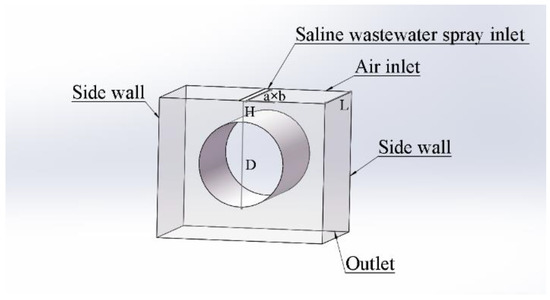
Figure 1.
Schematic diagram of calculation domain.

Table 1.
Scale parameters of the model.

Table 2.
Boundary conditions of the computing domain.

Table 3.
The parameter settings under various conditions.
2.2. Hypotheses and Thermophysical Properties of Salty Effluent
The hypotheses [21] of this study are as follows:
- Since the spray density is small and the droplet flow impact is not strong, the liquid film is assumed to be a three-dimensional laminar flow to keep the numerical model simple.
- The medium is a continuous and incompressible fluid and there is no shear at the surface of the liquid film (liquid-gas interface).
- Since the temperature rise of the fluid outside the tube is small, the thermophysical change of the fluid is ignored.
- Since the gas phase velocity has less effect on the liquid film, there is no slip velocity between the gas and liquid, and the air has no ability to adhere to the surface of the liquid film.
- Water and sodium sulfate are mixed completely.
The physical properties of the salty effluent are listed in Table 4. The data in Table 4 are obtained from Aspen Plus V10 software.

Table 4.
Physical properties of salty effluent.
2.3. Mathematical Model
The mathematical models are listed in Table 5.

Table 5.
Setting of the mathematical methods.
2.4. Grid Independence
The structured grids with numbers 347,612, 543,132, 690,800, and 956,340 are selected and compared, which is used to examine the numerical method’s dependence on the grid. Figure 2 shows the comparison of local heat transfer coefficients between simulations and experimental studies [24] for different mesh numbers. As seen, when the grid number increases from 347,612 to 690,800, the heat transfer coefficient undergoes significant variation, while the heat transfer coefficient shows little change when the grid number increases from 690,800 to 956,340. This indicates that a grid number higher than 690,800 has little effect on the simulation results. Finally, the grid with the number 690,800 is applied in the next research.
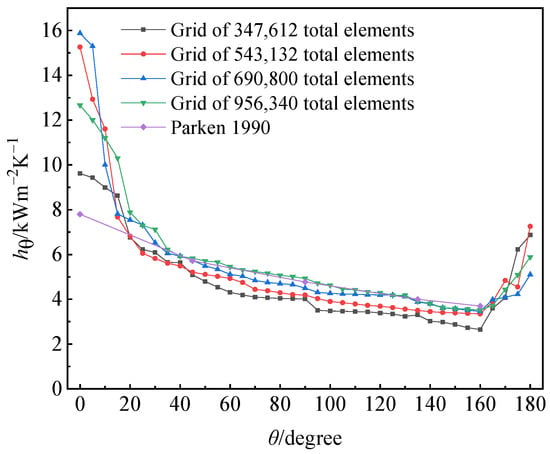
Figure 2.
Variations of local heat transfer coefficient with grid numbers [24].
2.5. Model Validation
Table 6 compares the local heat transfer coefficients of the present numerical calculations with the experimental results [24], sharing the same boundary conditions and variable parameters with the experiment, Γ = 0.168 kg·m−1·s−1; D = 25.4 mm; H = 6.3 mm; Ti = 82 °C. The average error value was about 0.53 kW·m−2·K−1, with an average relative error percentage of 2.16%. As a result, the numerical results are in very good match with the experimental data that the numerical model can now be applied. The experimental data are obtained after a long enough period of time for steady-state variation, while the simulation uses transient numerical results. The average error value and relative error in θ = 0° is 4.74 kW·m−2·K−1 and 53.63% respectively. Compared to the steady-state experiments, the transient flow is more complex and variable due to the disruption in the impingement region and the formation of the vortex. Then the simulated transient values obtained from the simulation in the impingement region have a larger error compared to the other two regions.

Table 6.
Comparison between present study and previous experimental study [24].
3. Research on Heat Transfer Properties of Drop Film Flow outside the Horizontal Tube
hθ is the value of the heat transfer coefficient at various angles around the tube, decided by Ti, q, and temperature of tube wall Tw,θ.
Reθ is a dimensionless number at various angles around the tube, characterizing the relative magnitude of the inertial and viscous forces when the fluid flows outside the tube, determined by the liquid film velocity uθ, tube diameter D, and fluid kinematic viscosity νi.
The local Weber number Weθ is a dimensionless number at various angles around the tube, reflecting the relative magnitude of the inertial force and surface tension when the fluid flows outside the tube, determined by the fluid density ρ, the liquid film velocity uθ, the tube diameter D and the surface tension coefficient σ.
The Prandtl number Pr is a dimensionless number that characterizes the relative magnitude of a fluid’s capability to transfer momentum to its ability to transfer heat, and is determined by specific heat at constant pressure cp, dynamic viscosity μi, and thermal conductivity λi.
The local Nusselt number Nuθ is a dimensionless number at various angles around the tube, reflecting the strength of convective heat transfer of the fluid outside the tube, determined by hθ, D, and λi.
The heat transfer process of the salty effluent sprayed external of the horizontal tube is mainly composed of the heat conduction inside the liquid film, the heat conduction of the tube wall, the convective heat transfer between the surface of the liquid film and the air, as well as the natural convection of the air outside the tube. The performance of heat transfer mainly relies on the effect of convective heat transfer between air and liquid film surface. Hence, the dimensionless numbers Reθ and Nuθ of salty effluent are selected to discuss the effects of Na2SO4 content, heat flux, spray density, and temperature on the heat transfer properties of the drop film flow outside the horizontal tube.
For the liquid film flow process outside the horizontal tube, the effects of dimensionless numbers Reθ and Weθ on the heat transfer properties are analyzed qualitatively. For the effect of the physical properties of salty effluent, the influence of the dimensionless number Pr on the heat transfer characteristics is qualitatively analyzed. In addition, the dimensionless number Nuθ is applied as the criterion for evaluating the effectiveness of heat transfer outside the horizontal tube. Finally, based on the quantitative analysis of the simulated data, the correlation equation of the dimensionless criterion applicable to the convective heat transfer process of salty effluent spraying film on the horizontal tube is summarized.
3.1. Effect of the Variation of Na2SO4 Content on the Heat Transfer Characteristics
When the circumferential angle is 0–30°, the first region is called the impingement region. The second region (30–160°) is called the thermal developing region, and the third region (160–180°) is called the departure region [21].
From Figure 3, It can be found that the variation of the local Reynolds number with different Na2SO4 content is small, and the Reθ is not greatly influenced by fluid viscous force because of the formation of the thicker liquid film outside the tube in the impingement region. In the thermal developing region, as the salt concentration of the effluent increases, the viscous force on the fluid increases, the flow rate around the tube decreases, and Reθ gradually decreases. In the departure region, on one hand, due to the accumulation of a large amount of effluent, the fluid film outside the horizontal tube thickens and the flow velocity around the tube drops sharply. As well, the minimum flow velocity of effluent appears with a salt concentration of 10%. On the other hand, due to the strong disturbance formed by the vortex effect, the difference in the velocity is smaller. The variation of the local Weber number is basically the same as the local Reynolds number.
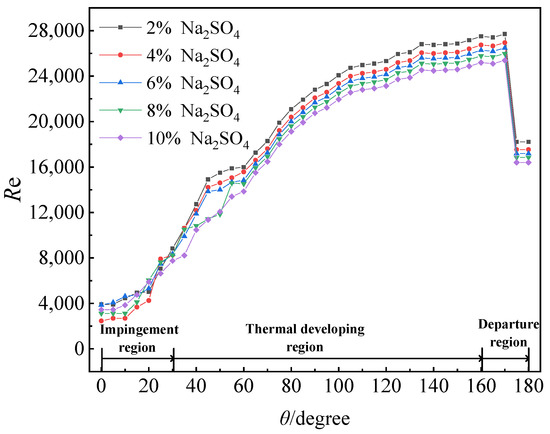
Figure 3.
Local Reynolds number around tube under various Na2SO4 content.
With the increase in concentration, the trend of Nuθ is shown in Figure 4. Compared to pure water solution, the partial elevation of salt content in the solution can enhance the solution perturbation of the impaction process in the impingement region, thus enhancing the heat transfer. However, as the salt content increases further, the viscosity gradually plays a key role, leading to a deterioration of heat transfer relative to pure water. The local Nusselt number decreases in the thermal developing region as the salt concentration of effluent increases, which is because of the various viscosity resulting in various flow velocities around the tube. In the departure region, Nuθ is the lowest for effluent with a salt concentration of 10%, and the difference is small due to the strong turbulence formed by the vortex. In the other two regions, the viscosity of the salty solution plays a dominant role relative to pure water, reducing the flow rate around the tube and leading to a thicker liquid film and a lower Nuθ.
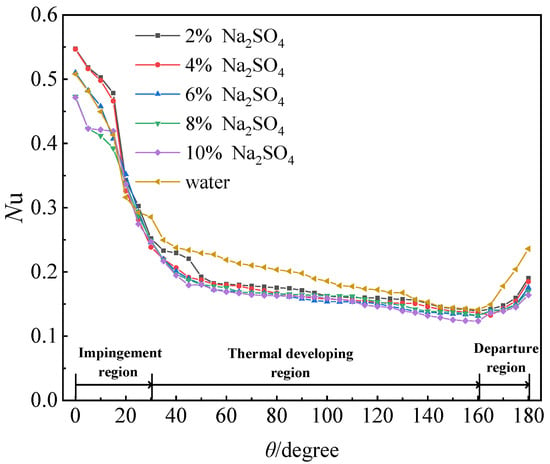
Figure 4.
Local Nusselt number around the tube under various Na2SO4 content.
3.2. Effect of Variation of Spray Density on Heat Transfer Characteristics
From Figure 5. The Reynolds number of the liquid film flow grows as the spray density grows. This is the fact that higher spray density causes greater inertia and more turbulence in the liquid film flow, and higher spray density causes greater turbulence in the impingement and departure region. Hence, the slope of the Reθ curve is larger and the velocity changes drastically in these two regions. In the thermal developing region, the liquid film flow velocity gradually increases and the liquid film thickness gradually declines due to the effect of gravity. However, with increasing spray density, the liquid film thickness gradually enlarges and the growth of liquid film flow velocity gradually becomes slower, which partially offsets the positive impact of inertia force. The variation of the local Weber number is the same as the local Reynolds number.
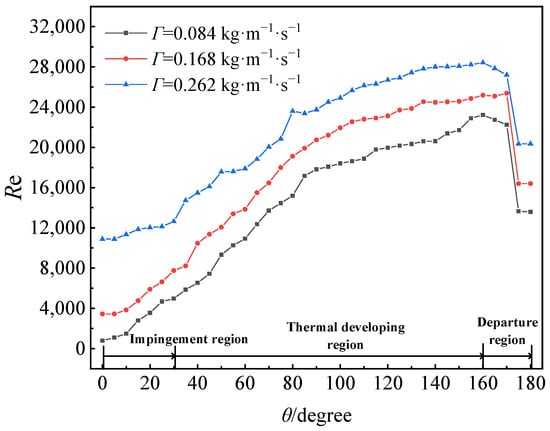
Figure 5.
Local Reynolds number around tube under various spraying densities.
The impact of spray density on the local Nusselt number is shown in Figure 6, it can be seen that Nuθ increases when the spray density increases from 0.084 kg·m−1·s−1 to 0.168 kg·m−1·s−1. This is due to the fact that with increasing spray density, the flow rate of the liquid film increases, thus promoting heat transfer. The influence of spray density is even more noticeable in the impingement region. Because the increase in velocity results in enhanced fluid mixing inside the liquid film at the top of the tube. However, Nuθ changes slightly when the spray density increases from 0.168 kg·m−1·s−1 to 0.262 kg·m−1·s−1. The higher spray density leads to an increase in film thickness, which increases the thermal resistance of heat conduction between the wall and the liquid film, which is detrimental to heat transfer and offsets the positive effect of velocity.
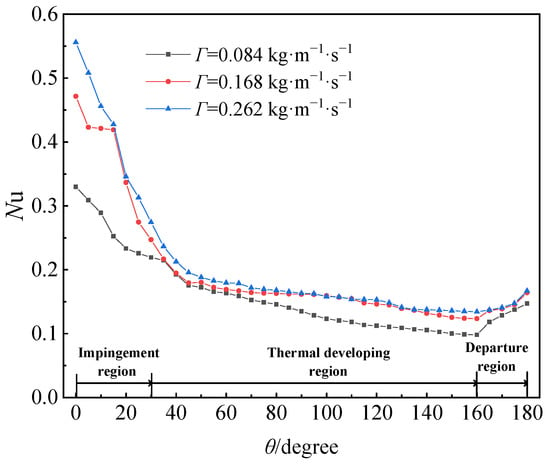
Figure 6.
Local Nusselt number around tube under various spraying densities.
3.3. Effect of Variation of Heat Flux on Heat Transfer Characteristics
As shown in Figure 7, the local Reynolds number is not greatly affected by the heat flux. It is observed that in the impingement region, the velocity gradient within the velocity boundary layer under the large heat flux condition is larger, thus strengthening the intensity of the vortex disturbance in this region. In the other two regions, with the increase of heat flux, on one hand, the liquid thermal properties do not change. On the other hand, the liquid velocity does not change much. Therefore, Reθ does not change much, the basic variation trend of which is consistent with other conditions. Also, the change of the local Weber number is the same as the local Reynolds number.
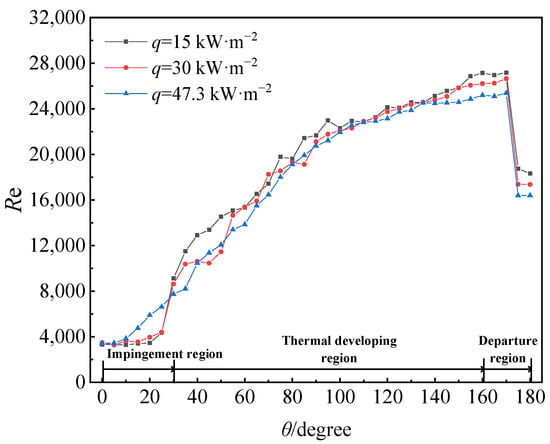
Figure 7.
Local Reynolds number around tube under various heat fluxes.
The local Nusselt number of mixed solutions drop film flow with different heat fluxes is shown in Figure 8. At the top of the tube, Nuθ is found to increase with increasing heat flux. This is because of the increased temperature gradient in the thermal boundary layer caused by the impact, which results in buoyancy effects and density differences. With the increased heat flux, natural convection in the radial direction is enhanced, resulting in the increase of Nuθ [26]. At the bottom of the tube, the impact effect disappears, and heat transfer by forced convection becomes dominant. The local Nusselt number is usually independent of the heat flux [24]. Therefore, in the thermal developing region, the heat flux does not seem to have a significant effect on Nuθ.
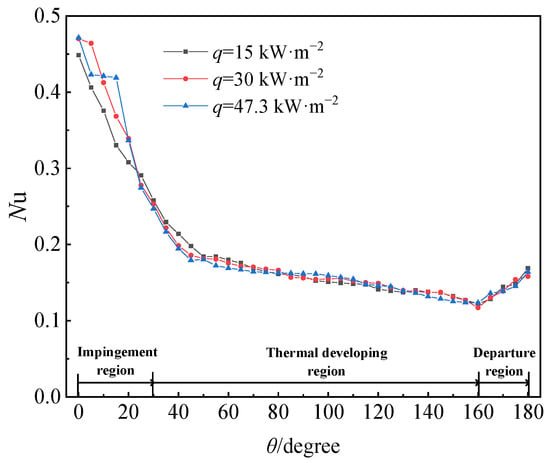
Figure 8.
Local Nusselt number around tube under various heat fluxes.
3.4. Effect of Variation of Spraying Temperature on Heat Transfer Characteristics
From Figure 9, the local Reynolds number grows with the increase of spraying temperature. The reason is that the film thickness declines with the growth of spraying temperature, and as shown in Table 4, the viscosity and surface tension of the liquid decreases with the increase of spraying temperature, which is beneficial to the expansion and thinning of the film. The local Weber number varies in the same rule as the local Reynolds number.
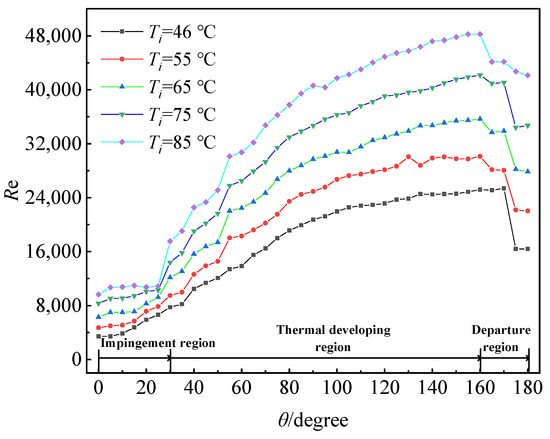
Figure 9.
Local Reynolds number around tube under various spraying temperatures.
The impact of the spraying temperature of the effluent on the local Nusselt number is shown in Figure 10. It can be seen that Nuθ grows with the growth of the spraying temperature. As the temperature grows, the viscosity of the fluid decreases, resulting in a decrease in the thickness of the liquid film and an increase in Nuθ. Heat transfer is also enhanced in terms of thermal conductivity because it increases with increasing temperature.
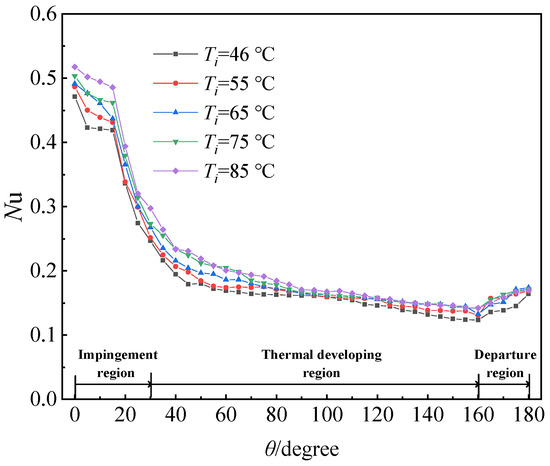
Figure 10.
Local Nusselt number around tube under various spraying temperatures.
3.5. Criterion-Related Equation for Heat Transfer
Firstly, considering the effects of inertial force, viscous force and physical parameters, the dimensionless criterion equation Equation (6) for the heat transfer process is determined. Based on the 592 sets of data obtained from the simulation, a nonlinear curve fitting is performed using the custom function of origin software to determine the values of each constant in the correlation equation.
In Equation (6), C = 73.3601 ± 10.1291, m = −0.4887 ± 0.0108, n = −0.9120 ± 0.0489.
Considering the large standard error of C and the large value of C, the effects of Reθ and Pr are easily being covered. Considering the increase of the Weber number Weθ associated with the surface tension, the dimensionless criterion equation Equation (7) for the heat transfer process was determined. Based on the correlation Equation (7), a nonlinear curve fitting is performed to determine the values of each constant in the dimensionless equation.
In Equation (7), C = 5.5995 ± 1.3040, m = −0.1847 ± 0.0249, n = −0.6608 ± 0.0448, k = −0.1794 ± 0.0121.
Comparing Equations (6) and (7), the standard error value of the constant C in Equation (7) is smaller. Besides, the value of C is also significantly reduced, which improves the fitting accuracy of the dimensionless criterion. It indicates that the effect of surface tension cannot be negligible.
As shown in Figure 11, four typical operating conditions are selected to compare the uncertainties between the fitted calculation results and the simulated data. Due to the flow chaos caused by the impact area, the flow becomes more complex and variable, and the error values between the fitted calculation results and the simulated data are larger compared with the other two areas. The average relative error in the impingement region is calculated to be 10.14%, and the average relative error in the other two regions is 5.49%.
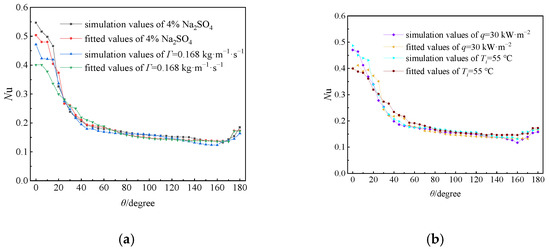
Figure 11.
Error comparison diagram of the fitted and simulated data. (a) Error comparison diagram of Na2SO4 content and spray density. (b) Error comparison diagram of heat flux and spraying temperature.
The Nusselt correlation (Equation (7)) is obtained based on 592 sets of data from the simulation, thus, experimental validation is included to confirm the applicability of this equation. As shown in Figure 12, three sets of experimental data are used to compare with the Nussle correlation (Equation (7)). On one hand, three sets of experimental and the Nussle correlation (Equation (7)) use different spraying media. On the other hand, compared to the steady-state experiments, the transient flow is more complex and variable due to the disruption in the impingement region and the formation of the vortex. Then the values of Nussle correlation (Equation (7)) obtained from the simulation data in the impingement region have a larger error compared to the other two regions, the value of which is 28.21%. Meanwhile, the average relative error in the thermal developing regions is 4.23%.
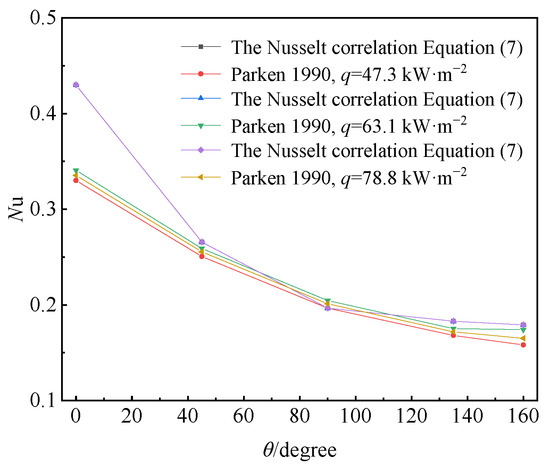
Figure 12.
Error comparison diagram of the fitted and experimental data [24].
4. Innovations
The following are the scientific novelties of this paper:
- The horizontal falling film evaporator is a key component of the mechanical vapor recompression crystallization system and the heat transfer and flow characteristics of the salty wastewater sprayed outside the horizontal falling film evaporator tube are obviously different from that of ordinary water. The evaluation method of this study provides recommendations for the optimization of the horizontal falling film evaporators in the MVRC system with salty wastewater as the external tube medium.
- The falling film flow of salty wastewater around horizontal tube was simulated using the three-dimensional model to couple fluid film surface velocity and temperature. In addition to the multiphase flow VOF model and the continuous surface force CSF model, the evaporation Lee model was also applied and it can simulate the salty effluent evaporation process more accurately.
- The effects of different sodium sulfate content, heat flux, spray density, and inlet spray temperature on the local heat transfer coefficient as well as the dimensionless parameters were investigated. Meanwhile, the research results and the dimensionless equations show some reference for the operating and energy-saving measures of the MVRC system.
5. Conclusions
In this paper, the heat transfer characteristics of the horizontal drop film evaporator with salty effluent flowing outside the tube in the MVRC system were studied, and we built a 3D model of the sprayed drop film with salty effluent on a horizontal tube heat exchanger.
In this study, the effluent with high salt concentration is applied as the heat transfer medium, and the salt-containing material weakens the heat transfer in the horizontal drop film evaporator of the MVRC system. Based on previous related studies, the heat transfer properties of horizontally drop film were also investigated. The quantitative effects of Na2SO4 content, heat flux, spray density, and temperature on heat transfer were obtained, and can be applied to further study and design the horizontal drop film evaporators in the MVRC system with salty effluent as the external tube medium.
The conclusions obtained are as follows:
- Characteristics in the impingement region (Reθ, Weθ, Nuθ)
In the impingement region, Na2SO4 content has little effect on Reθ. Reθ increases with increasing spray density, and Reθ becomes more significant at larger heat flux due to the larger velocity gradient within the velocity boundary layer. Na2SO4 content and heat flux value have little effect on Weθ, and Weθ increases with increasing spray density. Reθ and Weθ both increase with increasing inlet liquid spray temperature, while Weθ shows a smaller trend than Reθ. Na2SO4 content has little effect on local Nusselt number Nuθ, and Nuθ increases with increasing spraying density, but at higher spray density, the positive impact of velocity is offset by the negative impact of increasing film thickness. Besides, Nuθ increases with increased heat flux and spraying temperature.
- 2
- Characteristics in the thermal developing region (Reθ, Weθ, Nuθ)
In the thermal developing region, Reθ decreases with increasing Na2SO4 content. Reθ grows slowly with increasing spray density, and the positive effect of inertial forces is partially offset by the gradual increase in liquid film thickness. Heat flux has little impact on Reθ. Na2SO4 content and heat flux have little impact on Weθ, Weθ increases with increasing spray density. Reθ and Weθ both increase with increasing inlet liquid spray temperature, while in this region, Weθ also shows a smaller trend than Reθ. Local Nusselt number Nuθ declines with the growth of Na2SO4 content, and the impact of spray density on Nuθ is consistent with the impingement region. The heat flux has little impact on Nuθ, and Nuθ increases with increasing spraying temperature.
- 3
- Characteristics in the departure region (Reθ, Weθ, Nuθ)
In the departure region, Reθ is the lowest for the Na2SO4 content of 10%. Reθ increases with increasing spray density and increasing inlet liquid spray temperature, and heat flux have little impact on Reθ. Na2SO4 content and heat flux have little impact on Weθ, and Weθ increases with increasing spray density and increasing inlet liquid spraying temperature. Local Nusselt number Nuθ shares the same variation tendency with the four parameters as in the thermal developing region.
- 4
- The dimensionless equation
Based on the 592 sets of data obtained from the simulation, a nonlinear curve fitting was performed to obtain the dimensionless equation of the heat transfer criterion applicable to each variable parameter combination condition. On this basis, the correlation equation was modified by adding the effect of surface tension to improve the fitting accuracy.
Author Contributions
Conceptualization, Y.C. and Y.W.; methodology, Y.C. and Y.W.; validation, Y.G.; investigation, Y.C. and Y.W.; writing—original draft preparation, Y.C.; writing—review and editing, Y.W. and R.K.; supervision, Y.W. and R.K.; funding acquisition, Y.W. and Y.C. All authors have read and agreed to the published version of the manuscript.
Funding
This work is supported by the National Natural Science Foundation of China (Grant No. 51806096), Natural Science Foundation of Jiangsu Province for Postgraduate Practice and Innovation (Grant No. SJCX22_0467), China Postdoctoral Science Foundation (No. 2019M661812), and the Research Fund of Key Laboratory of Aircraft Environment Control and Life Support, MIIT, Nanjing University of Aeronautics and Astronautics (Grant No. KLAECLS-E-201902).
Conflicts of Interest
The authors declare no conflict of interest.
References
- GEP Research. Report on the Development of Industrial Waste Water Treatment Industry. 2018. Available online: http://www.gepresearch.com/77/view-764255-1.html (accessed on 25 September 2018).
- Zhou, Y.S.; Shi, C.J.; Dong, G.Q. Analysis of a mechanical vapor recompression wastewater distillation system. Desalination 2014, 353, 91–97. [Google Scholar] [CrossRef]
- Liang, L.; Han, D.; Ma, R.; Peng, T. Treatment of high-concentration wastewater using double-effect mechanical vapor recompression. Desalination 2013, 314, 139–146. [Google Scholar] [CrossRef]
- Jiang, H.; Zhang, Z.Y.; Gong, W.Q. Design and evaluation of a parallel-connected double-effect mechanical vapor recompression evaporation crystallization system. Appl. Therm. Eng. 2020, 179, 115646. [Google Scholar] [CrossRef]
- Shen, S.Q.; Chen, X.; Mu, X.S.; Jiang, C.K. Experimental Studies on Heat Transfer Coefficients of Horizontal Tube Falling Film Evaporation with Seawater. J. Heat Transf. 2017, 139, 011504. [Google Scholar] [CrossRef]
- Abraham, R.; Mani, A. Heat transfer characteristics in horizontal tube bundles for falling film evaporation in multi-effect desalination system. Desalination 2015, 375, 129–137. [Google Scholar] [CrossRef]
- Yang, L.P.; Liu, Y.; Yang, Y.; Shen, S.Q. Microscopic mechanisms of heat transfer in horizontal-tube falling film evaporation. Desalination 2016, 394, 64–71. [Google Scholar] [CrossRef]
- Chien, L.H.; Chen, R.H. An Experimental Study of Falling Film Evaporation on Horizontal Tubes Using R-134a. J. Mech. 2012, 28, 319–327. [Google Scholar] [CrossRef]
- Fujita, Y.; Tsutsui, M. Experimental investigation of falling film evaporation on horizontal tubes. Heat Transf. Jpn. Res. Co-Spons. Soc. Chem. Eng. Jpn. Heat Transf. Div. ASME 1998, 27, 609–618. [Google Scholar] [CrossRef]
- Zhao, C.Y.; Ji, W.T.; He, Y.L.; Zhong, Y.J.; Tao, W.Q. A comprehensive numerical study on the subcooled falling film heat transfer on a horizontal smooth tube. Int. J. Heat Mass Transf. 2018, 119, 259–270. [Google Scholar] [CrossRef]
- Ribatski, G.; Jacobi, A.M. Falling-film evaporation on horizontal tubes—A critical review. Int. J. Refrig. 2005, 28, 635–653. [Google Scholar] [CrossRef]
- Lin, S.; Liu, X.; Li, X.L. The spatial distribution of liquid film thickness outside the horizontal falling film tube. Int. J. Heat. Mass Transf. 2019, 143, 118577. [Google Scholar] [CrossRef]
- Yan, W.M.; Pan, C.W.; Yang, T.F.; Ghalambaz, M. Experimental study on fluid flow and heat transfer characteristics of falling film over tube bundle. Int. J. Heat Mass Transf. 2019, 130, 9–24. [Google Scholar] [CrossRef]
- Qi, C.H.; Feng, H.J.; Lv, H.Q.; Miao, C. Numerical and experimental research on the heat transfer of seawater desalination with liquid film outside elliptical tube. Int. J. Heat Mass Transf. 2016, 93, 207–216. [Google Scholar] [CrossRef]
- Asbik, M.; Ansari, O.; Zeghmati, B. Numerical study of boundary-layer transition in flowing film evaporation on horizontal elliptical cylinder. Numer. Heat Transf. Part A Appl. 2005, 48, 645–669. [Google Scholar] [CrossRef]
- Luo, L.C.; Zhang, G.M.; Pan, J.H.; Tian, M.C. Flow and heat transfer characteristics of falling water film on horizontal circular and non-circular cylinders. J. Hydrodyn. 2013, 25, 404–414. [Google Scholar] [CrossRef]
- Guo, Y.L.; Bao, M.L.; Gong, L.Y.; Sheng, S.Q.; Zhang, K. Numerical investigation of the falling film thickness and heat transfer characteristics over horizontal round tube. Int. J. Multiph. Flow 2022, 149, 103977. [Google Scholar] [CrossRef]
- Maliackal, A.K.; Ganesan, A.R.; Mani, A. Heat transfer enhanced surfaces for horizontal tube falling film evaporator characterized using laser interferometry. Appl. Eng. 2022, 210, 118303. [Google Scholar] [CrossRef]
- Tahir, F.; Mabrouk, A.; Koc, M. CFD Analysis of Falling Film Hydrodynamics for a Lithium Bromide (LiBr) Solution over a Horizontal Tube. Energies 2020, 13, 307. [Google Scholar] [CrossRef] [Green Version]
- Tahir, F.; Mabrouk, A.; Koc, M. Impact of surface tension and viscosity on falling film thickness in multi-effect desalination (MED) horizontal tube evaporator. Int. J. Sci. 2020, 150, 106235. [Google Scholar] [CrossRef]
- Jingyu, H.; Yingjie, X.; Tianbiao, H.; Ning, M.; Mengjie, S.; Jianfeng, T. Numerical study on heat transfer of oily wastewater spray falling film over a horizontal tube in a sewage source heat pump. Int. J. Heat Mass Transf. 2019, 142, 118423. [Google Scholar]
- Ruan, B.; Jacobi, A.M. Heat transfer characteristics of multiwall carbon nanotube suspensions (MWCNT nanofluids) in intertube falling-film flow. Int. J. Heat Mass Transf. 2012, 55, 3186–3195. [Google Scholar] [CrossRef]
- Hu, B.; Guo, J.J.; Yang, Y.; Shao, Y.Y. Experimental study on horizontal tube spray falling film evaporator in a low temperature geothermal binary cycle power system. Energy Rep. 2022, 8, 187–193. [Google Scholar] [CrossRef]
- Parken, W.H.; Fletcher, L.S.; Sernas, V.; Han, J.C. Heat-Transfer Through Falling Film Evaporation and Boiling on Horizontal Tubes. J. Heat Transf. ASME 1990, 112, 744–750. [Google Scholar] [CrossRef]
- Boyes, A.; Ponter, A. Wettability of copper and polytetrafluoroethylene surfaces with water—The influence of environmental conditions. Chem. Ing. Tech. 1973, 45, 1250–1256. [Google Scholar] [CrossRef]
- Meyer, J.P.; Everts, M. Single-phase mixed convection of developing and fully developed flow in smooth horizontal circular tubes in the laminar and transitional flow regimes. Int. J. Heat Mass Transf. 2018, 117, 1251–1273. [Google Scholar] [CrossRef] [Green Version]
Publisher’s Note: MDPI stays neutral with regard to jurisdictional claims in published maps and institutional affiliations. |
© 2022 by the authors. Licensee MDPI, Basel, Switzerland. This article is an open access article distributed under the terms and conditions of the Creative Commons Attribution (CC BY) license (https://creativecommons.org/licenses/by/4.0/).